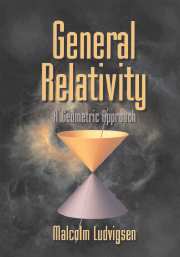Book contents
- Frontmatter
- Contents
- Preface
- PART ONE THE CONCEPT OF SPACETIME
- PART TWO FLAT SPACETIME AND SPECIAL RELATIVITY
- PART THREE CURVED SPACETIME AND GRAVITY
- 9 Curved Spacetime
- 10 Curvature and Gravity
- 11 Null Congruences
- 12 Asymptotic Flatness and Symmetries
- 13 Schwarzschild Geometries and Spacetimes
- 14 Black Holes and Singularities
- PART FOUR COSMOLOGY
- Solutions and Hints to Selected Exercises
- Bibliography
- Index
14 - Black Holes and Singularities
Published online by Cambridge University Press: 04 June 2010
- Frontmatter
- Contents
- Preface
- PART ONE THE CONCEPT OF SPACETIME
- PART TWO FLAT SPACETIME AND SPECIAL RELATIVITY
- PART THREE CURVED SPACETIME AND GRAVITY
- 9 Curved Spacetime
- 10 Curvature and Gravity
- 11 Null Congruences
- 12 Asymptotic Flatness and Symmetries
- 13 Schwarzschild Geometries and Spacetimes
- 14 Black Holes and Singularities
- PART FOUR COSMOLOGY
- Solutions and Hints to Selected Exercises
- Bibliography
- Index
Summary
Spherical Gravitational Collapse
One of the most remarkable predictions of general relativity is that, under extreme – but by no means unobtainable – conditions, gravitational collapse can lead inexorably to arbitrarily high densities and, ultimately, to a spacetime singularity. Gravitational collapse takes place when the internal pressure in a body (e.g., a star) is insufficient to counteract the inward pull of gravity. Since the pressure increases as the body contracts, one might expect that there will always come a point when this will be sufficient to prevent further contraction and that the star will settle down in some stable but denser state. This is indeed the case for a star of mass equal to that of the sun. The theory of stellar evolution tells us that such stars can reach a final equilibrium state as a white dwarf or a neutron star. However, for slightly larger stars, no such final equilibrium state is possible, and in such a case the star will contract beyond a certain critical point – the point of no return – where complete gravitational collapse leading to a spacetime singularity is inevitable.
In this section we restrict attention to the idealized case of spherically symmetric collapse, but, as we shall see later, the same phenomenon also occurs in a more general setting.
In order to gain an intuitive view of gravitational collapse, we first consider the case of Newtonian gravity.
- Type
- Chapter
- Information
- General RelativityA Geometric Approach, pp. 152 - 172Publisher: Cambridge University PressPrint publication year: 1999

